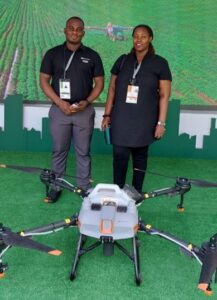East Africa is home to a significant number of smallholder farmers who play a crucial role in the region’s agricultural landscape. Climate change poses unprecedented challenges for these farmers, affecting crop yields, water availability, and overall food security. In the pursuit of sustainable and climate-resilient farming practices, smart agricultural practices such as the integration of satellite data with spraying drones, as enumerated below, emerge as transformative solutions for East Africa’s smallholder farmers.
Precision Agriculture for Smallholder Farms:
Smallholder farmers in East Africa face varying climatic conditions and soil types across their fields. Satellite data facilitates precision agriculture by providing real-time insights into weather patterns, soil health, and crop conditions. These insights empower farmers to make informed decisions about resource management.
Satellite Data:
A Weather Watchdog for East African Farmers: Satellites act as weather watchdogs, offering continuous monitoring of meteorological conditions. This is particularly crucial in East Africa, where the prevalence of extreme weather events, such as droughts and floods, can significantly impact agriculture. Smallholder farmers can utilise satellite-derived early warning systems to prepare for and mitigate the effects of adverse weather conditions.
Empowering Smallholder Farmers with Drones:
Integrating spraying drones into the farming toolkit brings a new level of efficiency and precision. Smallholder farmers can deploy drones equipped with precise spraying technology to target specific areas identified through satellite data. This not only optimises the use of inputs like pesticides and fertilisers but also reduces costs for resource-constrained farmers.
Real-Time Decision-Making for Climate Resilience:
The real-time nature of both satellite data and drone technology enables East African farmers to make quick decisions in response to changing weather conditions. Drones can be deployed promptly to address emerging issues detected through satellite observations, allowing farmers to adapt their crop management strategies in the face of evolving challenges.
Adaptive Crop Management in East Africa:
The dynamic agricultural conditions in East Africa demand adaptive crop management. Satellite data guides farmers in understanding the specific needs of their crops, while drones offer a means of implementing precise interventions. This synergy ensures that smallholder farmers can respond effectively to the ever-changing environmental factors affecting their crops.
Climate-Resilient Strategies for Pest Management:
Satellite data contributes to the development of models predicting pest outbreaks based on environmental conditions. Spraying drones can then implement Integrated Pest Management (IPM) strategies, targeting specific areas with higher pest risk. This not only minimises the use of broad-spectrum pesticides but also promotes sustainable pest management practices.
Enhancing Resilience through Data-Driven Insurance:
In East Africa, where the livelihoods of smallholder farmers are highly vulnerable to climate shocks, the combination of satellite data and spraying drones can enhance the effectiveness of weather-indexed insurance. Real-time data validation ensures accurate assessments of crop damage, enabling timely and fair compensation for farmers.
In conclusion, the convergence of satellite data and spraying drones represents a groundbreaking opportunity for climate-resilient farming for East Africa’s smallholder farmers. By harnessing the power of these technologies, farmers in the region can overcome the challenges posed by climate change, optimise resource use, and build a sustainable and prosperous agricultural future. This innovative synergy not only improves the resilience of East African agriculture but also contributes to global efforts towards a more sustainable and food-secure planet.







